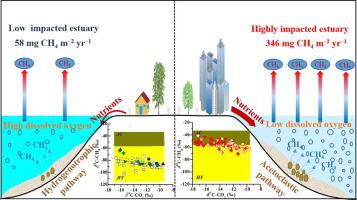Journal of Hydrology ( IF 6.4 ) Pub Date : 2022-06-16 , DOI: 10.1016/j.jhydrol.2022.128061 Xiaofei Li , Mengting Qi , Dengzhou Gao , Min Liu , Lijun Hou

|
Nutrient loading caused by human activities can drive changes in methane (CH4) production pathways, yet the mechanisms and magnitudes of estuary CH4 emissions remain poorly understood. Here we investigated CH4 fluxes and δ13C-CH4 values in wet and dry seasons from five subtropical estuaries with varying human activity intensity and hydrologic conditions. Water dissolved CH4 concentrations varied from 0.19 to 0.51 µmol CH4 L–1 in these studied estuaries, resulting in coincident water–air CH4 fluxes ranging from 5.46 to 29.6 µg CH4 m–2h−1. Water CH4 concentrations and fluxes were significantly lower in the wet than dry season, and were higher in the high human-impacted estuaries, indicating that large discharge and water flow could slow down areal CH4 emissions. The ratios of C-CH4 to organic carbon (OC) were much higher and showed a positive response to increasing nitrogen concentrations in high human-impacted estuaries, suggesting that eutrophic estuaries trigger high CH4 emissions. In addition, an increase in δ13C-CH4 and a declining in fractionation factor (αapp) from the low to high human-impacted estuaries were accompanied by a switch of CH4 production from hydrogenotrophic to acetoclastic pathways. These results suggest that human activity intensity can drive the alterations in the pathways and magnitudes of CH4 production and that hydrologic conditions can modify CH4 emissions, which have important implications for estimates of CH4 emissions from global estuaries under increasing human activity intensity.
中文翻译:

亚热带河口甲烷产生途径和排放随人类活动强度的变化
人类活动引起的营养负荷可以推动甲烷 (CH 4 ) 生产途径的变化,但对河口 CH 4排放的机制和量级仍知之甚少。在这里,我们调查了人类活动强度和水文条件不同的五个亚热带河口在湿季和旱季的 CH 4通量和δ 13 C-CH 4值。在这些研究的河口,水中溶解的 CH 4浓度从 0.19 到 0.51 µmol CH 4 L –1不等,导致水-空气 CH 4通量一致,范围从 5.46 到 29.6 µg CH 4 m –2 h-1。湿季水体 CH 4浓度和通量显着低于旱季,而在人为影响高的河口则更高,表明大流量和水流可以减缓区域 CH 4排放。C-CH 4与有机碳 (OC) 的比率要高得多,并且对人为影响高的河口中氮浓度的增加表现出积极的反应,这表明富营养化的河口会引发高 CH 4排放。此外,从低人类影响河口到高人类影响河口,δ 13 C-CH 4的增加和分馏因子 ( α app ) 的下降伴随着 CH 的转换4从氢营养到乙酸分解途径的生产。这些结果表明,人类活动强度可以驱动 CH 4产生的路径和量级的改变,并且水文条件可以改变 CH 4排放,这对于在人类活动强度增加的情况下估算全球河口的 CH 4排放具有重要意义。


























 京公网安备 11010802027423号
京公网安备 11010802027423号